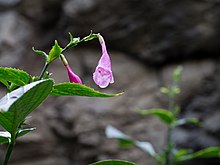Strobilanthes
| Strobilanthes | |
|---|---|

| |
| Strobilanthes species, cultivated in Hawaii | |
| Scientific classification | |
| Kingdom: | Plantae |
| Clade: | Tracheophytes |
| Clade: | Angiosperms |
| Clade: | Eudicots |
| Clade: | Asterids |
| Order: | Lamiales |
| Family: | Acanthaceae |
| Subfamily: | Acanthoideae |
| Tribe: | Ruellieae |
| Genus: | Strobilanthes Blume |
| Species | |
| Synonyms[1] | |
|
List
| |

Strobilanthes is a genus of about 350 species[2] of flowering plants in the family Acanthaceae, mostly native to tropical Asia and Madagascar, but with a few species extending north into temperate regions of Asia. Many species are cultivated for their two-lipped, hooded flowers in shades of blue, pink, white and purple. Most are frost-tender and require protection in frost-prone areas.[3]
Selected species

Strobilanthes atropurpurea is a temperate species, native to eastern Siberia; it is cultivated for its purple flowers.
Strobilanthes dyeriana (Persian shield) is a tropical plant native to Myanmar. It is grown for its dark green foliage with bright, metallic-purple stripes radiating outward from the central leaf vein. In proper conditions, it will also produce pale purple flowers. Persian Shield grows best outdoors in USDA zones 9 and 10, although it can survive in other zones as a houseplant given sufficient temperature, soil moisture and humidity. It has gained the Royal Horticultural Society's Award of Garden Merit.[4]
Strobilanthes species are used as food plants by the larvae of some Lepidoptera species including Endoclita malabaracus, which has been recorded on S. callosa.
There is currently (December 2017) a database conflict about the status of Pachystrobilus involucratus, with the Catalogue of Life placing the species in this genus.[5]
References
- ^ "Strobilanthes Blume". Plants of the World Online. Board of Trustees of the Royal Botanic Gardens, Kew. 2017. Retrieved 10 July 2020.
- ^ Moylan, Elizabeth C.; Bennett, Jonathan R.; Carine, Mark A.; Olmstead, Richard G.; Scotland, Robert W. (2004). "Phylogenetic relationships among Strobilanthes s.l. (Acanthaceae): evidence from ITS nrDNA, trnL-F cpDNA, and morphology" (PDF). American Journal of Botany. 91 (5). American Journal of Botany, Inc.: 724–735. doi:10.3732/ajb.91.5.724. PMID 21653427. Retrieved 10 December 2013.
- ^ RHS A-Z encyclopedia of garden plants. United Kingdom: Dorling Kindersley. 2008. p. 1136. ISBN 978-1405332965.
- ^ "RHS Plant Selector - Strobilanthes dyeriana". Retrieved 5 July 2013.
- ^ Roskov Y.; Kunze T.; Orrell T.; Abucay L.; Paglinawan L.; Culham A.; Bailly N.; Kirk P.; Bourgoin T.; Baillargeon G.; Decock W.; De Wever A. (2014). Didžiulis V. (ed.). "Species 2000 & ITIS Catalogue of Life: 2014 Annual Checklist". Species 2000: Reading, UK. Retrieved 1 December 2017.
External links
 Data related to Strobilanthes at Wikispecies
Data related to Strobilanthes at Wikispecies Media related to Strobilanthes at Wikimedia Commons
Media related to Strobilanthes at Wikimedia Commons
